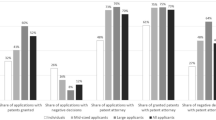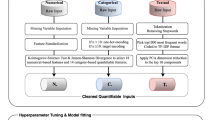Abstract
The emergence of patent citations as a tool for patent estimation has been subjected to equally vocal champions and critics. In additional to patent citation, this article aims to contribute other factors, including court decisions, claim language, extension cases, patent family and portfolio, which should be deliberated during patent evaluation. It introduces the subject-matter by discussing the specialties and peculiarities of these proposed factors. Furthermore, comparisons between the patent citations and these factors are presented by illustrating several well-known patents. The results of the comparisons reveal that an adverse conclusion might be drawn if a patent is estimated only based on citations. The conclusion supports Meyer’s study that “the general nature of a common framework for both scientific and patent citations would severely limit its usefulness.” Therefore, those factors discussed in the article would be a great asset in patent evaluation. However, it only illustrates their impact on patent estimation using a couple well-known patents. Future research would be needed to investigate these factors in a more detailed manner.
Similar content being viewed by others
References
Bayer AG v. Housey Pharmaceuticals, 02-1598, U.S. Court of Appeals for the Federal Circuit, 22 August 2003.
D. Malakoff, US court opens door to free trade in ideas, Science, 301 (2003) 1643.
F. Narin, Patent bilbiometrics, Scientometrics, 30 (1994) 147–155.
M. Meyer, Patent citations in a novel field of technology — What can they tell about interactions between emerging communities of science and technology, Scientometrics, 48(2) (2000) 151–178.
M. Meyer, What is special about patent citations? Differences between scientific and patent citations, Scientometrics, 49(1) (2000) 93–123.
W. Glänzel, M. Meyer, Patents cited in the scientific literatures: An exploratory study of ‘reverse’ citation relations, Scientometrics, 58(2) (2003) 415–428.
F. Narin, M. Albert, P. Kroll, D. Hicks, The Link between Australian Patenting and Basic Science, CHI Research, Inc., 2000.
É. Gauthier, Bibliometric Analysis of Scientific and Technological Research: A User’s Guide to the Methodology, Science and Technology Redesign Project, Statistics Canada, September 1998.
The Division of Science Resources Statistics (SRS) of the National Science Foundation, Technological Importance of Asian patents, www.nsf.gov/srs/s4495/conten1b.htm
M. M. S. Karki, K. S. Krishnan, Patent citation analysis: a policy analysis tool, World Patent Information, 19(4) (1998) 269–272.
R. Dalpe, Bibliometrics analysis of biotechnology, Scientometrics, 55(2) (2002) 189–213.
D. Hicks, F. Narin, Strategic research alliance and 360 degree bibliometric indicators, Strategic research partnerships: Proceeding from an NSF Workshop, Arlington, VA (NSF 01-336), August 2001.
V. M. Smith, Who’s who in additives — a technological approach, Chem. Weekly, 38 (1993) 137–142.
B. H. Hall, A. Jaffe, M. Trajtenberg, Market value and patent citations, The Rand Journal of Economics, 36(1) (2005) 16–38.
A. K. Chakrabarti, Competition in high technology: analysis of problems of US, Japan, UK, France, West Germany and Canada. IEEE Trans Eng Mang. EM-38(1) (1991) 78–84.
W. G. Hanchuk, How to read a patent: understanding the language of proprietary rights. In: From Ideas to Assets, In: B. Berman (Ed.), John Wiley & Sons, Inc., New York, 2002.
A. F. Breitzman, F. Narin, Method and Apparatur for Choosing a Stock Portfolio, Based on Patent Indicators, US Patent 6175824, 2001.
F. Narin, D. Olivastro, Technology indicators based on patents and patent citations. In: A. F. J. Van Raan (Ed.), Handbook of Quantitative Studies of Science and Technology, North Holland: Elsevier Publisher, 1988.
F. Narin, V. M. Smith, M. B. Albert, What patents tell you about your competition, Chemtech, 23(2) (1993) 52–69.
Shyh-Jen Wang, Patent Engineering (in Chinese), Jun Jie Academy Corporation, Taipei, Taiwan, ROC, 2002.
P. W. Grubb, Patents for Chemicals, Pharmaceuticals and Biotechnology, Oxford University Press, New York, 1999.
M. P. Carpenter, F. Narin, Validation study: patent citations as indicators of science and foreign dependence, World Patent Information, 5(3) (1983) 180–185.
A. Verbeek, K. Debackere, M. Luwel, Science cited in patents: a geographic “flow” analysis of bibliographic citation patterns in patents, Scientometrics, 58(2) (2003) 241–263.
M. Meyer, Does science push technology? Patents citing scientific literature, Research Policy, 29 (2000) 409–434.
W. Kondro, Canadian High Court Rejects OncoMouse, Science, 298 (2002) 2112–2113
The Regents of the University of California v. Eli Lilly and Company, 96-1175, U.S. Court of Appeals for the Federal Circuit, 22 July 1997.
D. Pressman, Patent It Yourself, 8th edition, Nolo, Berkelet, CA USA, 2000.
H. J. Knight, Patent Strategy for Researchers and Research Managers, John Wiley & Sons, Ltd, New York, USA (2001).
G. Stix, Working system II, Scientific American, (2004) (3) 41.
The basic filing fee for the US utility patent is $770 or $385 for small entity (if applicable), www.uspto.gov/go/fees/fee2004jul26.htm
Bertran Rowland and Cohen/Boyer cloning patent, www.law.gwu.edu/tech/rowland.asp
The definition of ‘Family’ by the Delphion Patent database (www.delphion.com).
The patent maintenance fees due at 3.5, 7.5 and 11.5 years are $910, $2090 and $3220 or $455, $1045 and $1610 for small entity if applicable.
D. Kennedy, Academic Duty, Harvard University Press, Cambridge, Massachusetts, USA, 1997.
O. Granstrand, The Economics and Management of Intellectual Property, Edward Elgar Publishing, Camberley UK, 2000.
G. Stix, Take a number, toilet reservations afford a glimpse of the world of business-method patents, Scientific American, Staking Claims 2003/2, 2003.
P. Thomas, F. Narin, System and Method for Producing Technology-based Price Targets for a Company Stock. US Patent 6832211, 2004 Sec. 14 issued.
J. A. Barney, J. R. Barney, V. A. McLean, Method and System for Rating Patents and Other Intangible Assets. US Patent 6556992, 2003 Apr. 29 issued.
Author information
Authors and Affiliations
Corresponding author
Rights and permissions
About this article
Cite this article
Wang, SJ. Factors to evaluate a patent in addition to citations. Scientometrics 71, 509–522 (2007). https://doi.org/10.1007/s11192-007-1698-8
Received:
Issue Date:
DOI: https://doi.org/10.1007/s11192-007-1698-8




